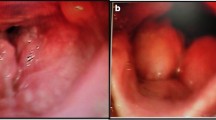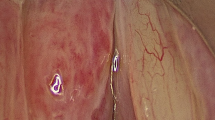Abstract
The aim of this study was to determine the incidence of laryngeal tuberculosis (LT) among patients with active pulmonary tuberculosis. A total of 319 patients under treatment for pulmonary tuberculosis were subjected to laryngoscopy. Five patients (1.5%) with LT were identified. Odynophagia was the most common complaint, followed by alteration in voice. The larynx returned to its normal appearance in 3–8 months (average 18 weeks) by antituberculous medication. Physicians dealing with pulmonary tuberculosis should keep in mind that symptoms of laryngeal involvement may be minor, and laryngoscopy should always be performed when laryngeal involvement is suspected in order to isolate highly infectious patients. Response to antituberculous medication is usually late in LT and diagnosis by “wait and watch” policy will cause a significant delay in the diagnosis of a possible larynx carcinoma.

Similar content being viewed by others
References
World Health Organization (2001). Global tuberculosis control, WHO report 2001. Geneva, Switzerland, WHO/CDS/TB/2001.287
Mert A (2003) Erişkinlerde yüzeysel tüberküloz lenfadenopati. Proceedings of tuberculosis and its diagnosis in 21st century symposium, Samsun, Turkey, pp 93–105
Munck K, Mandpe AH (2003) Mycobacterial infections of the head and neck. Otolaryngol Clin North Am 36(4):569–76
Beg MH, Marfani S (1985) The larynx in pulmonary tuberculosis. J Laryngol Otol 99(2):201–203
Rohwedder JJ (1974) Upper respiratory tract tuberculosis. Sixteen cases in a general hospital. Ann Intern Med 80(6):708–713
Brodovsky DM (1975) Laryngeal tuberculosis in an age of chemotherapy. Can J Otolaryngol 4(1):168–176
Williams RG, Douglas-Jones T (1995) Mycobacterium marches back. J Laryngol Otol 109(1):5–13
Diagnostic standards and classification of tuberculosis in adults and children (2000) This official statement of the American Thoracic Society and the Centers for Disease Control and Prevention was adopted by the ATS Board of Directors, July 1999. This statement was endorsed by the Council of the Infectious Disease Society of America, September 1999. Am J Respir Crit Care Med 161(4 Pt 1):1376–1395
Manni H (1983) Laryngeal tuberculosis in Tanzania. J Laryngol Otol 97(6):565–570
Fetterhof G (1914) Cited by Du Plessis A, Hussey G (1987). Laryngeal tuberculosis in childhood. Pediatr Infect Dis J 6:678–681
Borgdorff MW, Nagelkerke NJ, Dye C, Nunn P (2000) Gender and tuberculosis: a comparison of prevalence surveys with notification data to explore sex differences in case detection. Int J Tuberc Lung Dis 4(2):123–132
Holmes CB, Hausler H, Nunn P (1998) A review of sex differences in the epidemiology of tuberculosis. Int J Tuberc Lung Dis 2(2):96–104
Tu HY, Li HY, Huang TS (1997) Laryngeal tuberculosis: a series of 46 patients. Changgeng Yi Xue Za Zhi 20(2):94–99
Martinez AN, Rhee JT, Small PM, Behr MA (2000) Sex differences in the epidemiology of tuberculosis in San Francisco. Int J Tuberc Lung Dis 4(1):26–31
Watkins RE, Plant AJ (2006) Does smoking explain sex differences in the global tuberculosis epidemic? Epidemiol Infect 134(2):333–339
Shin JE, Nam SY, Yoo SJ, Kim SY (2000) Changing trends in clinical manifestations of laryngeal tuberculosis. Laryngoscope 110:1950–1953
Ramadan HH, Tarazi AE, Baroudy FM (1993) Laryngeal tuberculosis: presentation of 16 cases and review of the literature. J Otolaryngol 22(1):39–41
Riley EC, Amundson DE (1992) Laryngeal tuberculosis revised. Am Fam Physician 49:759–762
Bailey CM, Windle-Taylor PC (1981) Tuberculous laryngitis: a series of 37 patients. Laryngoscope 91(1):93–100
Thaller SR, Gross JR, Pilch BZ, Goodman ML (1987) Laryngeal tuberculosis as manifested in the decades 1963–1983. Laryngoscope 97(7 Pt 1):848–850
Harney M, Hone S, Timon C, Donnelly M (2000) Laryngeal tuberculosis: an important diagnosis. J Laryngol Otol 114(11):878–880
Author information
Authors and Affiliations
Corresponding author
Rights and permissions
About this article
Cite this article
Topak, M., Oysu, C., Yelken, K. et al. Laryngeal involvement in patients with active pulmonary tuberculosis. Eur Arch Otorhinolaryngol 265, 327–330 (2008). https://doi.org/10.1007/s00405-007-0459-x
Received:
Accepted:
Published:
Issue Date:
DOI: https://doi.org/10.1007/s00405-007-0459-x




